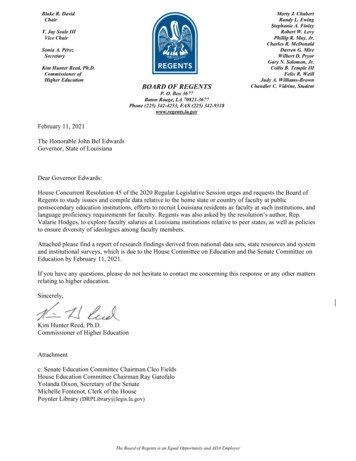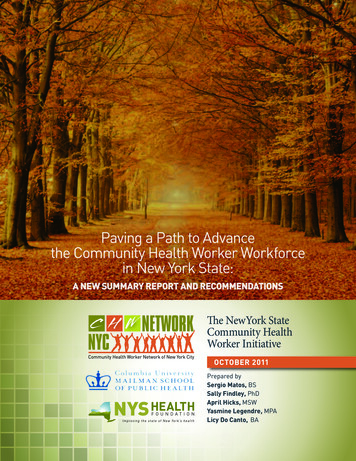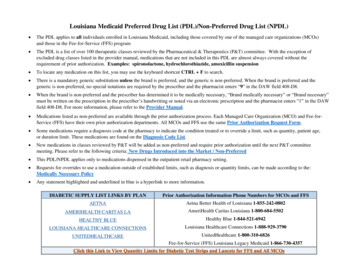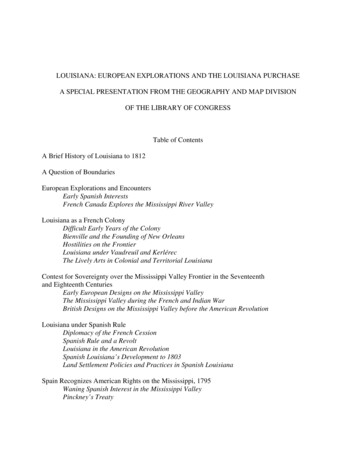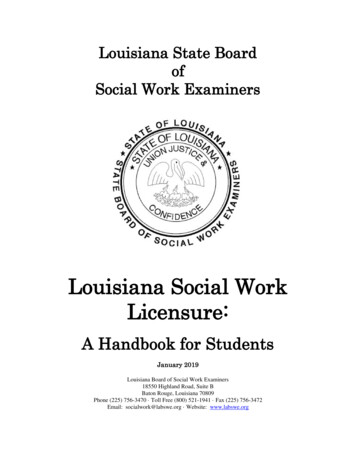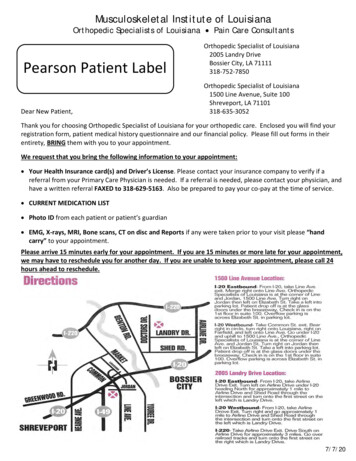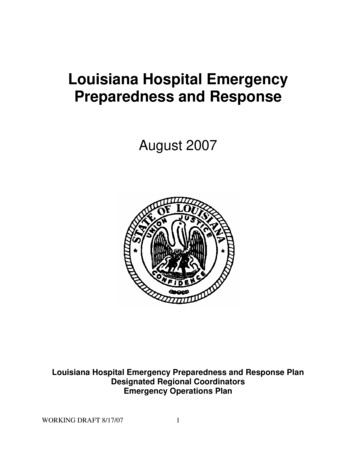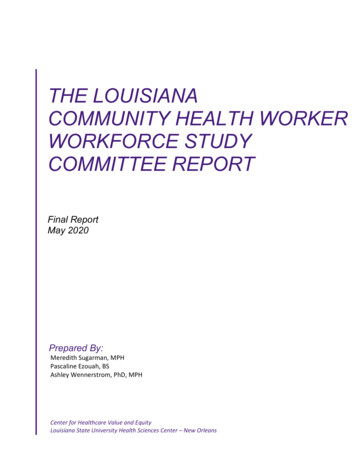
Transcription
THE LOUISIANACOMMUNITY HEALTH WORKERWORKFORCE STUDYCOMMITTEE REPORTFinal ReportMay 2020Prepared By:Meredith Sugarman, MPHPascaline Ezouah, BSAshley Wennerstrom, PhD, MPHCenter for Healthcare Value and EquityLouisiana State University Health Sciences Center – New Orleans
Intentionally left blank
TABLE OF CONTENTSEXECUTIVE SUMMARY . 1INTRODUCTION . 2METHODS . 4DATABASE DEVELOPMENT . 4DATA COLLECTION . 4DATA ANALYSIS . 4LIMITATIONS . 5RESULTS . 6DEMOGRAPHICS OF SURVEY AND INTERVIEW PARTICIPANTS . 6CHW ROLES AND ACTIVITIES. 10CHW roles and activities in Louisiana. 10Positive aspects of the CHW profession . 13Challenging aspects of the CHW profession . 14Career opportunities for CHWs . 16CHW PROGRAM ADMINISTRATION . 17Hiring CHWs . 17CHW program structure . 18CHW program challenges. 21Strategies for expanding the CHW workforce in Louisiana . 23Supporting CHWs . 23Creating new CHW positions . 25TRAINING . 27CHW training experience . 28Training content for Louisiana CHWs . 29Perceived benefits of standardized training . 30Concerns about standardized training . 31Training administration. 32CERTIFICATION. 34Knowledge about certification . 34Perceived benefits of certification . 34Concerns about certification . 37RECOMMENDATIONS. 40REFERENCES. 42
ACKNOWLEDGEMENTSWe would like to acknowledge the efforts of the Louisiana Community Health Outreach Network(LACHON), without which this work would not have been possible. We are also grateful to everyone whotook the time to participate in surveys and interviews for this study.LOUISIANA COMMUNITY HEALTH WORKER WORKFORCE STUDY COMMITTEE MEMBERSNick Albares, Office of Governor John Bel EdwardsDazmine Allen, CHW, Independent Community Health WorkerMarcus Bachhuber, Louisiana MedicaidSenator Regina Barrow, Louisiana State SenateAlexander Billioux, Louisiana Office of Public HealthTerry Birkoff, Taking Aim at Cancer in LouisianaGerrelda Davis, Louisiana Primary Care AssociationJeanie Donovan, Louisiana Department of HealthIesha Gabriel, CHW, Louisiana Office of Public HealthIsaac Gilliard, CHW, Louisiana Office of Public HealthAshley Hill Hamilton, CHW/Doula, Birthmark Doula CollectiveCatherine Haywood, CHW, LACHON (Committee co-lead)Charles Haywood, CHW, Women With a VisionSamantha Joseph, CHW, Louisiana Office of Public HealthKathy Kleibert, Louisiana Managed Medicaid AssociationRosalyn Mariano, CHW, DePaul Community Health CenterDanielle Metz, CHW, Formerly Incarcerated Transitions ClinicRepresentative Patricia Moore, Louisiana House of RepresentativesMargaret Pitre, CHW, Louisiana Office of Public HealthGail Sherman, CHW, Volunteers of AmericaFernando Sosa, CHW, Tulane UniversityAshley Wennerstrom, LSU Health Sciences Center (Committee co-lead)Michelle Wiley, CHW, Women with a Vision
EXECUTIVE SUMMARYCommunity health workers (CHWs) are frontline public health professionals who are trusted membersof and/or have an unusually close understanding of the communities they serve. Through a variety ofactivities such as health education, outreach, and connecting underserved populations to resources,CHWs improve health outcomes, reduce hospitalizations and emergency department use, decreasehealth care costs, and enhance quality of care. Moreover, CHWs address the social determinants thatinfluence health, such as housing, food, and education by connecting people to community resources.They can also help improve the community conditions that can lead to poor health.CHWs are currently underutilized in Louisiana. In 2019, the Louisiana Legislature created the LouisianaCommunity Health Worker Workforce Study Committee (Committee) to provide the LouisianaDepartment of Health with recommendations on how best to support and expand this workforce.The Committee examined major CHW policy issues, including options for training CHWs and financingtheir positions. In addition to reviewing best practices and examining peer-reviewed literature, theCommittee collected data about Louisiana CHW and employer perspectives on workforce developmentissues through a survey and in-depth interviews. Sixty-five CHWs and 37 employers participated in thesurvey. Additionally, 21 CHWs and 15 employers completed an interview.Based on this work, the Committee recommends the following:1. Members of the Louisiana CHW Workforce Study Committee, along with other stakeholders,should continue to collaborate as a CHW Workgroup. At least half of the Workgroup membersshould be CHWs. The Workgroup should advise on ongoing CHW workforce policy issues andsupport implementation of the recommendations listed below.2. The State of Louisiana should adopt and use the American Public Health Association CHWdefinition for all State CHW policies and programs.3. The State of Louisiana should adopt the CHW Core Consensus (C3) Project as a guideline fordeveloping CHW programs and ensure that Louisiana CHWs have the capacity and support tocarry out the full range of CHW roles.4. The CHW Workgroup should provide technical assistance to CHW-led professional groups. Thesegroups can support the workforce by convening CHWs and offering training.5. The CHW Workgroup should create a process to evaluate and recognize standardized CHW corecompetency training programs. Certifying CHWs is not recommended at this time.6. The CHW Workgroup should create a voluntary, online CHW registry in partnership with CHWprofessional groups.7. The CHW Workgroup should collaborate to develop a broad, statewide educational campaignabout CHW roles and program implementation models for health care providers, communitybased organizations, public health practitioners, and the general public.8. The CHW Workgroup should provide technical assistance to organizations that currently employCHWs or plan to hire CHWs. This support should include sharing best practices in CHW programdevelopment and implementation, as well as data collection strategies.9. All State CHW programs should use common, standardized measures to track CHW programs andoutcomes.10. The CHW Workgroup should collaborate with Louisiana Medicaid to create a CHW benefit to befinanced on a per member per month basis.1
INTRODUCTIONLouisiana has high rates of chronic disease, maternal mortality, and sexually transmitted infections.1-3Over 14% of Louisiana adults had diabetes in 2019, compared to a national prevalence of 10.4%,1 andLouisiana ranked 4th in the country for adults with hypertension, at 39% of the population.2 The rate ofmaternal mortality between 2011 and 2016 was 12.4 deaths per 100,000 live births, with Black womenfour times more likely to experience pregnancy-related death than their White counterparts.3Health outcomes across the state also vary significantly based on location. On average, people living inSouth Louisiana enjoy better health than those in the northern half of the state.4 Social and economicfactors like education, transportation, and housing weigh heavily into Louisiana’s disparate healthoutcomes, as do health behaviors such as tobacco use.4Community health workers (CHWs) can contribute to addressing these issues. CHW is an umbrella termthat covers a wide variety of job titles, including community health representative, outreach worker,promotor, and community health navigator, among others. According to the American Public HealthAssociation:Community health workers (CHWs) are frontline public health workers who are trustedmembers of and/or have an unusually close understanding of the community served. Thistrusting relationship enables CHWs to serve as a liaison/link/intermediary between health/socialservices and the community to facilitate access to services and improve the quality and culturalcompetence of service delivery. CHWs also build individual and community capacity byincreasing health knowledge and self-sufficiency through a range of activities such as outreach,community education, informal counseling, social support and advocacy.5CHWs work in a wide variety of settings such as Federally Qualified Health Centers, community-basedorganizations, health departments, and universities. They are recognized for their ability to reducehospitilizations,6 decrease health care costs,7-9 and enhance quality of care.10 CHWs are also effective inhelping people prevent and manage chronic diseases, such as cardiovascular disease and type 2diabetes.10 Research has shown that CHWs can improve use of preventive and primary care amongindividuals with a chronic disease.11 Moreover, CHWs address the social determinants of health (e.g.housing, food security, transportation, education, and other factors) by connecting individuals andfamilies to community resources,10 and by improving community conditions that affect health.12CHWs have been serving their communities in the U.S. since the 1950s.13 Since then, the workforce hasevolved organically, with little standardization of programs or workforce policy. In 1998, the NationalCommunity Health Advisor Study14 was the first systematic effort to document CHW activitiesnationwide. Roughly a decade later, the Community Health Worker National Workforce Study furtherillustrated the scope of CHW programs throughout the U.S.13Throughout the past decade, there has been increasing focus on expanding and supporting the CHWworkforce across the country. For example, the Community Health Worker Core Consensus (C3) Project,which included representation from Louisiana, engaged CHWs and experts nationwide to define CHWs’core roles and skills.15 CHWs and other stakeholders also recently established the National Associationof Community Health Workers to represent members of the workforce.16Although these national efforts have been important, the majority of policies related to the CHWworkforce are made at the state level. One major question that states often struggle to answer is how topay CHWs, as these positions are generally financed by short-term grants,17,18 rather than sustainablesources of funding. In some cases, Medicaid has supported CHW positions and achieved health care2
cost-savings.19 For example, in New Mexico, CHWs paid on a per member per month (PMPM) basis forthe services they offer to Medicaid managed care members have achieved a 4:1 return on investment.20Recently, another study showed that CHWs helped high-risk patients improve chronic health conditions,resulting in cost savings for Medicaid.21Generally, for a CHW to be paid through Medicaid, a state must adopt a CHW definition and specifywhat experience or training a CHW must have. As of 2020, sixteen states have implemented or are in theprocess of creating programs to certify CHWs, with the hope that formalizing the workforce will createnew mechanisms for funding CHWs.22 However, there has been little research on how such credentialingmay affect the CHW workforce.Over the last several decades, Louisiana’s CHW workforce has developed informally through a widevariety of programs led by the Louisiana Office of Public Health, community-based organizations,Federally Qualified Health Centers, hospitals, neighborhood groups, and universities. They haveaddressed a variety of health conditions including asthma, obesity, HIV, lead poisoning prevention,diabetes, and maternal and child health.In 2010, a group of CHWs and CHW supporters established the Louisiana Community Health OutreachNetwork (LACHON) to serve as a professional association for CHWs. In 2011, LACHON collaborated witha university-based researcher to develop the only CHW-informed core competency training program inLouisiana, which has been used to train approximately 150 people across the state. LACHON provideseducational opportunities for CHWs and hosts monthly membership meetings for CHWs to shareresources. Since 2013, LACHON has also held an annual conference for CHWs.In 2019, a Legislative Resolution established the Louisiana Community Health Worker Workforce StudyCommittee (Committee) to examine the state’s current CHW workforce and provide the LouisianaDepartment of Health with policy recommendations on how best to support and expand the CHWworkforce. In keeping with nationally established best practices,23 the Committee was required to be atleast 50% CHWs. It was co-led by an experienced CHW who directs LACHON and a researcher who hasstudied and collaborated with CHWs for a dozen years.The charge of this Committee was to provide recommendations on the following: The CHW definition to be used in LouisianaSkills, roles, and competencies for Louisiana CHWsHow to develop CHW training infrastructure in LouisianaEnhancing Louisiana employer readiness for hiring CHWsTracking CHW employment in LouisianaSustainable methods of financing CHWs in LouisianaWhether certification is necessary or desirable in LouisianaWe, the members of this Committee, met at total of six times between July 2019 and February 2020.Two subcommittees (CHW Training and CHW Financing) met two to three times each. We alsocollaborated to conduct a formal study of CHWs and their employers. Below, we describe in detail ourmethods, results, and recommendations.3
METHODSDATABASE DEVELOPMENTWe began our study by creating a database of CHWs and CHW employers throughout the state. Westarted with an existing list of CHW employers (e.g. non-profit organizations, Federally Qualified HealthCenters, social service agencies, etc.) that LACHON had previously assembled. To this list we added thenames of individual CHWs, CHW programs, and employers that Committee members knew, as well asnames of individuals and programs that other community partners shared with us. We also reviewedcommunity resource lists, conducted web-based searches, and made announcements at communitymeetings to identify additional possible CHWs, programs, and employers. We placed phone calls toagencies to verify contact information of all CHWs and employers. These CHWs and their employers alsoshared information about other CHW programs with which they were familiar. We then added theseindividuals and agencies to the database and contacted them to verify CHW employment.DATA COLLECTIONDuring a Committee meeting, we reviewed and agreed upon a list of topics about which we wanted togather CHW and CHW employers’ input. The group agreed that demographics (e.g. age, education, andregion of employment), CHW activities and roles, desire for training, knowledge about CHWcredentialing, ideas for expanding the workforce, and financing issues should be explored. All of thesetopics were aligned with the charge of the Committee.We collected data about CHW and employer perspectives in two ways: a survey and in-depth interviews.Survey questions were based on a survey tool used for a similar workforce study in another state. Wedeveloped a semi-structured interview guide that covered the above-mentioned topics in greater detail.Members of the Committee reviewed questions and provided suggestions for improvement before webegan the study.We announced the launch of the study at LACHON’s 7th annual conference in September 2019, whichhad roughly 70 CHWs and employers in attendance. Participants who were interested in completing asurvey during the conference had the option to do so on paper or on a tablet. After the conference, wesent via email an online link to the CHW and employer survey to conference participants, people on anexisting LACHON email distribution list, as well as to all people in the database. We sent multiplereminders and encouraged people to forward the survey links to other CHWs and employers. We alsooffered the opportunity for CHWs to fill out a paper-based survey at LACHON monthly meetings inOctober, November, and December 2019. We completed survey data collection in December 2019.To gather in-depth perspectives on our areas of interest, we reached out to a subset of CHWs andemployers to invite them to participate in an interview. We contacted potential participants by phone oremail, depending on the availability of contact information. We aimed to interview CHWs and employerswho worked in all regions of Louisiana and in a variety of settings. Interviews were conducted in personor by phone between October and December 2019. An experienced CHW interviewed CHWs and anexperienced CHW program administrator interviewed employers. We audio-recorded all interviews anda professional service transcribed all recordings verbatim.DATA ANALYSISData from the survey were mostly quantitative. We used a SPSS software (version 26) to tabulateresponses to questions and summarize findings. In some cases, participants did not answer all questions.We report the number (n) of responses for each question.To interpret the information gathered from the interviews, we used applied thematic analysistechniques, in which text is organized into smaller chunks, or quotations, to identify common themes4
across interviewees. The two interviewers collaborated to develop a list of codes to help categorizequotations and used a software program, Atlas.ti (Version 8.4.4), to assign codes to all quotations. Wethen examined the quotations assigned to each code to help identify key themes. We present keyquotations that illustrate these themes in the results section below.LIMITATIONSIt is important to acknowledge that this study has limitations. Although we tried to identify CHWs andemployers throughout Louisiana, it is likely that we did not locate all of them. The perspectives of CHWsand employers who were not identified or chose not to participate in the study could vary from thosewho opted to participate. CHWs with lower levels of education or limited computer literacy skills mayhave been less likely to respond, and their perspectives may also be different from participants’ views.In spite of these limitations, this study provides new insight into an important workforce in Louisiana.5
RESULTSDEMOGRAPHICS OF SURVEY AND INTERVIEW PARTICIPANTSTable 1: Survey Participant DemographicsCommunity Health Workers(n 65)n (%)23-70Employers(n 37)n (%)26-63Age, years, mean SD42.6 13.045.0 9.5Sex*FemaleMaleGenderqueerNon-binaryTransgender FemaleTransgender MaleTransmasculine44 (67.7%)9 (13.8%)1 (1.5%)1 (1.5%)1 (1.5%)1 (1.5%)1 (1.5%)27 (73.0%)5 (13.5%)-7 (10.8%)5 (13.5%)35 (53.8%)14 (21.5%)6 (9.2%)2 (3.1%)4 (6.2%)3 (4.6%)15 (40.5%)12 (32.4%)3 (8.1%)2 (5.4%)7 (10.8%)6 (16.2%)51 (78.5%)7 (10.8%)31 (83.8%)1 (2.7%)7 (10.8%)5 (13.5%)14 (21.5%)20 (30.8%)17 (26.2%)4 (6.2%)2 (3.1%)22 (59.5%)6 (16.2%)4 (10.8%)-8 (12.3%)5 (13.5%)VariableAge, years, rangeUnknown**Race***African American/BlackWhiteNative American/American IndianAsian/Pacific IslanderOtherPrefer not to answerUnknown**EthnicityNon-HispanicHispanic or LatinoUnknown**EducationGraduate/Professional degreeBachelor’s degreeSome college or 2-year degreeHigh school or GEDLess than high schoolUnknown*** Participants were asked to report their sex and were given the option to write in their answer. Five (7.7%), wrote in their gender aslisted in the table.**Participant(s) did not provide an answer to this question.***Participants had the option to check more than one answer. Percentages may not total to 100% and total number of responsesmay be greater than the number of respondents (n).6
Table 2: CHW Survey Participant EmploymentCommunity Health Workers (n 65)n (%)VariableType of OrganizationFederally Qualified Health CenterCommunity Based OrganizationHealth DepartmentManaged Care OrganizationHospitalParish Health UnitUniversityOtherUnknown*Employment StatusFull timePart timeUnknown*Hours per week, mean SDYears of experience, rangeYears of experience, mean SDLocation**Region 1Region 2Region 3Region 4Region 5Region 6Region 7Region 8Region 9Unknown*26 (40.0%)19 (29.2%)7 (10.8%)5 (7.7%)1 (1.5%)1 (1.5%)1 (1.5%)1 (1.5%)4 (6.2%)57 (87.7%)6 (9.2%)2 (3.1%)36.1 9.90-375.7 7.743 (66.2%)10 (15.4%)5 (7.7%)6 (9.2%)3 (4.6%)4 (6.2%)1 (1.5%)7 (10.8%)2 (3.1%)*Participant(s) did not provide an answer to this question.**Participants had the option to check more than one answer. Percentages may not total to 100% and total number of responsesmay be greater than the number of respondents (n).7
Table 3: CHW Survey Participants’ Most Commonly Reported Titlesn 65n (%)14 (21.5%)11 (16.9%)9 (13.8%)3 (4.6%)3 (4.6%)3 (4.6%)2 (3.1%)2 (3.1%)2 (3.1%)2 (3.1%)2 (3.1%)2 (3.1%)9 (13.8%)1 (1.5%)Title ReportedCommunity Health WorkerCoordinatorCommunity Health NavigatorOutreach Specialist/DirectorCare ManagerPatient NavigatorCertified Application CounselorCommunity Health EducatorCommunity Health Services RepresentativeNavigatorPeer Prevention SpecialistPrevention NavigatorOtherUnknown**Participant(s) did not provide an answer to this question.Table 4: Interview Participant DemographicsCommunity Health WorkersVariablen 21n (%)Age, years, range24-74Employersn 15n (%)26-63Age, years, mean SD44.4 14.744.0 10.3GenderFemaleMale17 (81.0%)4 (19.0%)13 (86.7%)2 (13.3%)Race*African American/BlackWhiteNative American/American IndianAsian/Pacific IslanderOther17 (81.0%)4 (19.0%)2 (9.5%)1 (4.8%)-8 (53.3%)5 (33.3%)2 (13.3%)1 (6.7%)EthnicityNon-HispanicHispanic or Latino19 (90.5%)2 (9.5%)14 (93.3%)1 (6.7%)EducationGraduate/Professional degreeBachelor’s degreeSome college or 2-year degreeHigh school or GEDLess than high school5 (23.8%)7 (33.3%)9 (42.9%)-12 (80.0%)2 (13.3%)1 (6.7%)-*Participants had the option to check more than one answer. Percentages may not total to 100% and total number of responsesmay be greater than the number of respondents (n).8
Table 5: Interview Participant EmploymentVariableType of OrganizationCommunity Based OrganizationFederally Qualified Health CenterHealth DepartmentManaged Care OrganizationParish Health UnitUniversityOtherEmployment StatusFull timePart timeVolunteerHours per week, mean SDYears at current organization, rangeYears at current organization, mean SDLocation*Region 1Region 2Region 3Region 4Region 5Region 6Region 7Region 8Region 9Community Health Workersn 21n (%)Employersn 15n (%)7 (33.3%)5 (23.8%)5 (23.8%)1 (4.8%)1 (4.8%)1 (4.8%)1 (4.8%)2 (13.3%)3 (20.0%)1 (6.7%)3 (20.0%)1 (6.7%)2 (13.3%)3 (20.0%)20 (95.2%)1 (4.8%)39.2 1.8.3-103.4 3.114 (93.3%)1 (6.7%)40.3 8.1.5-19.87.1 6.713 (61.9%)5 (23.8%)3 (14.3%)4 (19.0%)2 (9.5%)2 (9.5%)2 (9.5%)2 (9.5%)2 (9.5%)7 (46.7%)3 (20.0%)2 (13.3%)1 (6.7%)1 (6.7%)1 (6.7%)-*Participants had the option to check more than one answer. Percentages may not total to 100% and total number of responsesmay be greater than the number of respondents (n).9
CHW ROLES AND ACTIVITIESCHW roles and activities vary based on the type of agency in which they are employed, the health orsocial issues that the they address, and the communities they serve. In 1998, the Community HealthAdvisor Study first began to articulate the full range of roles in which CHWs can engage.14 Since then,researchers and workforce advocates have reasoned that clearer definitions of CHWs’ roles and skillscould enhance program and policy development, increase appreciation of the CHW role among otherhealth professionals, and facilitate CHWs’ integration into health care delivery teams.24In 2016, the CHW Core Consensus (C3) Project conducted national research to document CHW roles andskills.15 A CHW from Louisiana was one of two CHWs selected from throughout the nation to help leadthe project. The following core roles were found to be consistent nationwide: Cultural mediation among individuals, communities, and health and social service systemsProviding culturally appropriate health education and informationCare coordination, case management, and system navigationProviding coaching and social supportAdvocating for individuals and communitiesBuilding individual and community capacityProviding direct serviceImplementing individual and community assessmentsConducting outreachParticipating in evaluation and research15National recommendations advise that states seeking to develop their CHW workforce should begin byexploring the roles that CHWs in that state currently fill.25CHW ROLES AND ACTIVITIES IN LOUISIANABased on our survey findings, CHW roles in Louisiana are generally consistent with those identified bynational research. CHW survey participants reported that their roles included individual or communityoutreach and education, care coordination, conducting outreach, and participating in communitydevelopment actions, among other activities.10
Table 6: CHW Roles and ActivitiesRolesIndividual or community outreach and educationCare coordinationConducting outreachParticipating in community coalitions or community developmentactivitiesMedical appointments (e.g., scheduling, maintaining, etc.)Communicating between providers and patients/familiesIndividual or community needs assessmentCase managementTeaching health literacyPromoting healthy lifestyles (e.g. nutrition, exercise, etc.)Informal support/counselingMotivational interviewingHelping patients with medication/treatment adherenceSupport groups (e.g. organizing, leading)Assisting with transitions of care (e.g. post hospital discharge)Chronic disease self-managementUnknown*n 65n (%)52 (80.0%)41 (63.1%)40 (61.5%)36 (55.4%)35 (53.8%)33 (50.8%)31 (47.7%)30 (46.2%)29 (44.6%)28 (43.1%)21 (32.3%)21 (32.3%)18 (27.7%)14 (21.5%)13 (20.0%)10 (15.4%)1 (1.5%)Participants had the option to check more than one answer. Percentages may not total to 100% and total number of responses maybe greater than the number of respondents (n).*Participant(s) did not provide an answer to this question.We also found that Louisiana CHWs connect clients and patients to a variety of services including healthinsurance enrollment, education assistance/resources, food assistance, and transportation.Table 7: Resources to
2 INTRODUCTION Louisiana has high rates of chronic disease, maternal mortality, and sexually transmitted infections.1-3 Over 14% of Louisiana adults had diabetes in 2019, compared to a national prevalence of 10.4%,1 and Louisiana ranked 4th in the country for adults with hypertension, at 39% of the population.2 The rate of four times more likely to experience pregnancy-related death than their .


